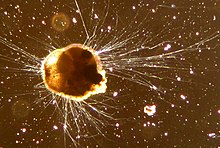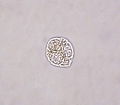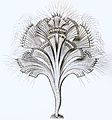| Revision as of 21:25, 18 May 2019 edit84.208.233.159 (talk)No edit summary← Previous edit |
Revision as of 17:51, 6 July 2019 edit undoCitation bot (talk | contribs)Bots5,426,204 editsm Alter: title, pages, issue, journal. Add: volume, issue, author pars. 1-6. Removed URL that duplicated unique identifier. Removed accessdate with no specified URL. Formatted dashes. | You can use this bot yourself. Report bugs here.| Activated by User:Marianne ZimmermanNext edit → |
| Line 15: |
Line 15: |
|
}} |
|
}} |
|
|
|
|
|
The '''Rhizaria''' are a species-rich supergroup of mostly ]<ref>{{cite web | url = http://www.palaeos.com/Eukarya/Units/Rhizaria/Rhizaria.html | year = 2004 | author = Christopher Taylor | title = Rhizaria | deadurl = yes | archiveurl = https://web.archive.org/web/20090420034036/http://www.palaeos.com/Eukarya/Units/Rhizaria/Rhizaria.html | archivedate = 2009-04-20 | df = }}</ref> ]s.<ref name="pmid15148395">{{cite journal |vauthors=Nikolaev SI, Berney C, Fahrni JF, etal |title=The twilight of Heliozoa and rise of Rhizaria, an emerging supergroup of amoeboid eukaryotes |journal=Proc. Natl. Acad. Sci. U.S.A. |volume=101 |issue=21 |pages=8066–71 |date=May 2004 |pmid=15148395 |pmc=419558 |doi=10.1073/pnas.0308602101 |url=http://www.pnas.org/cgi/pmidlookup?view=long&pmid=15148395}}</ref> Except from the ] and three species in the genus ], they are all non-photosyntethic. A multicellular form, ''Guttulinopsis vulgaris'', a cellular ], has also been described.<ref>{{cite journal | url=http://www.cell.com/current-biology/abstract/S0960-9822(12)00413-7 | year = 2012 | author = Brown| title = Aggregative Multicellularity Evolved Independently in the Eukaryotic Supergroup Rhizaria |display-authors=etal | doi=10.1016/j.cub.2012.04.021 | volume=22 | journal=Current Biology | pages=1123–1127 | pmid=22608512}}</ref> |
|
The '''Rhizaria''' are a species-rich supergroup of mostly ]<ref>{{cite web | url = http://www.palaeos.com/Eukarya/Units/Rhizaria/Rhizaria.html | year = 2004 | author = Christopher Taylor | title = Rhizaria | deadurl = yes | archiveurl = https://web.archive.org/web/20090420034036/http://www.palaeos.com/Eukarya/Units/Rhizaria/Rhizaria.html | archivedate = 2009-04-20 | df = }}</ref> ]s.<ref name="pmid15148395">{{cite journal |vauthors=Nikolaev SI, Berney C, Fahrni JF, etal |title=The twilight of Heliozoa and rise of Rhizaria, an emerging supergroup of amoeboid eukaryotes |journal=Proc. Natl. Acad. Sci. U.S.A. |volume=101 |issue=21 |pages=8066–71 |date=May 2004 |pmid=15148395 |pmc=419558 |doi=10.1073/pnas.0308602101 }}</ref> Except from the ] and three species in the genus ], they are all non-photosyntethic. A multicellular form, ''Guttulinopsis vulgaris'', a cellular ], has also been described.<ref>{{cite journal | url=http://www.cell.com/current-biology/abstract/S0960-9822(12)00413-7 | year = 2012 | author = Brown| title = Aggregative Multicellularity Evolved Independently in the Eukaryotic Supergroup Rhizaria |display-authors=etal | doi=10.1016/j.cub.2012.04.021 | volume=22 | issue = 12 | journal=Current Biology | pages=1123–1127 | pmid=22608512}}</ref> |
|
This supergroup was proposed by ] in 2002. Being described mainly from ] sequences, they vary considerably in form, having no clear morphological distinctive characters (]), but for the most part they are ]s with filose, reticulose, or microtubule-supported ]s. Many produce shells or skeletons, which may be quite complex in structure, and these make up the vast majority of protozoan fossils. Nearly all have ] with tubular ]e. |
|
This supergroup was proposed by ] in 2002. Being described mainly from ] sequences, they vary considerably in form, having no clear morphological distinctive characters (]), but for the most part they are ]s with filose, reticulose, or microtubule-supported ]s. Many produce shells or skeletons, which may be quite complex in structure, and these make up the vast majority of protozoan fossils. Nearly all have ] with tubular ]e. |
|
|
|
|
| Line 46: |
Line 46: |
|
Rhizaria are part of the ] (bikont) ] along with ], ], ], ], and ]. |
|
Rhizaria are part of the ] (bikont) ] along with ], ], ], ], and ]. |
|
|
|
|
|
Historically, many rhizarians were considered ]s because of their motility and ]. However, when a simple animal-plant dichotomy was superseded by a recognition of additional kingdoms, taxonomists generally placed rhizarians in the kingdom ]. When scientists began examining the evolutionary relationships among eukaryotes using molecular data, it became clear that the kingdom ] was ]. Rhizaria appear to share a common ancestor with ] and ] forming part of the SAR (Stramenopiles+Alveolates+Rhizaria) super assemblage.<ref>{{cite journal | title = Phylogenomics Reshuffles the Eukaryotic Supergroups| journal = ]| year = 2007 | volume = 2 | pages = e790– | issue = 8| url = http://www.plosone.org/article/info%3Adoi%2F10.1371%2Fjournal.pone.0000790| accessdate = 2008-01-24| doi = 10.1371/journal.pone.0000790 | pmid = 17726520 | last1 = Burki | first1 = F| last2 = Shalchian-Tabrizi | first2 = K | last3 = Minge | first3 = M | last4 = Skjaeveland | first4 = A | last5 = Nikolaev | first5 = SI | last6 = Jakobsen | first6 = KS | last7 = Pawlowski | first7 = J | pmc = 1949142 | editor1-last = Butler | editor1-first = Geraldine |
|
Historically, many rhizarians were considered ]s because of their motility and ]. However, when a simple animal-plant dichotomy was superseded by a recognition of additional kingdoms, taxonomists generally placed rhizarians in the kingdom ]. When scientists began examining the evolutionary relationships among eukaryotes using molecular data, it became clear that the kingdom ] was ]. Rhizaria appear to share a common ancestor with ] and ] forming part of the SAR (Stramenopiles+Alveolates+Rhizaria) super assemblage.<ref>{{cite journal | title = Phylogenomics Reshuffles the Eukaryotic Supergroups| journal = ]| year = 2007 | volume = 2 | pages = e790– | issue = 8| doi = 10.1371/journal.pone.0000790 | pmid = 17726520 | last1 = Burki | first1 = F| last2 = Shalchian-Tabrizi | first2 = K | last3 = Minge | first3 = M | last4 = Skjaeveland | first4 = A | last5 = Nikolaev | first5 = SI | last6 = Jakobsen | first6 = KS | last7 = Pawlowski | first7 = J | pmc = 1949142 | editor1-last = Butler | editor1-first = Geraldine |
|
}}</ref> Rhizaria has been supported by molecular phylogenetic studies as a monophyletic group.<ref name=Burki2008>{{cite journal|last1=Burki |first1=Fabien |last2=Shalchian-Tabrizi |first2=Kamran |last3=Pawlowski |first3=Jan |title=Phylogenomics reveals a new ‘megagroup’ including most photosynthetic eukaryotes |journal=Biology Letters |date=August 23, 2008 |doi=10.1098/rsbl.2008.0224 |pmid=18522922 |url=http://rsbl.royalsocietypublishing.org/content/4/4/366 |accessdate=15 January 2015 |volume=4 |issue=4 |pmc=2610160 |pages=366–9}}</ref> Biosynthesis of ] precursors in various rhizaria<ref>{{Cite journal|last=Hallmann|first=Christian|last2=Stuhr|first2=Marleen|last3=Kucera|first3=Michal|last4=Zonneveld|first4=Karin|last5=Bobrovskiy|first5=Ilya|last6=Bowser|first6=Samuel S.|last7=Pawlowski|first7=Jan|last8=Deckker|first8=Patrick De|last9=Nowack|first9=Eva C. M.|date=2019-03-04|title=Putative sponge biomarkers in unicellular Rhizaria question an early rise of animals|url=https://www.nature.com/articles/s41559-019-0806-5|journal=Nature Ecology & Evolution|language=en|pages=1|doi=10.1038/s41559-019-0806-5|issn=2397-334X}}</ref> suggests a relevant ecological role already during the ]. |
|
}}</ref> Rhizaria has been supported by molecular phylogenetic studies as a monophyletic group.<ref name=Burki2008>{{cite journal|last1=Burki |first1=Fabien |last2=Shalchian-Tabrizi |first2=Kamran |last3=Pawlowski |first3=Jan |title=Phylogenomics reveals a new 'megagroup' including most photosynthetic eukaryotes |journal=Biology Letters |date=August 23, 2008 |doi=10.1098/rsbl.2008.0224 |pmid=18522922 |volume=4 |issue=4 |pmc=2610160 |pages=366–9}}</ref> Biosynthesis of ] precursors in various rhizaria<ref>{{Cite journal|last=Hallmann|first=Christian|last2=Stuhr|first2=Marleen|last3=Kucera|first3=Michal|last4=Zonneveld|first4=Karin|last5=Bobrovskiy|first5=Ilya|last6=Bowser|first6=Samuel S.|last7=Pawlowski|first7=Jan|last8=Deckker|first8=Patrick De|last9=Nowack|first9=Eva C. M.|date=2019-03-04|title=Putative sponge biomarkers in unicellular Rhizaria question an early rise of animals|journal=Nature Ecology & Evolution|volume=3|issue=4|language=en|pages=577–581|doi=10.1038/s41559-019-0806-5|issn=2397-334X}}</ref> suggests a relevant ecological role already during the ]. |
|
|
|
|
|
===Phylogeny=== |
|
===Phylogeny=== |
|
Phylogeny based on Bass et al. 2009,<ref name="pmid18952499">{{cite journal |vauthors=Bass D, Chao EE, Nikolaev S |title=Phylogeny of Novel Naked Filose and Reticulose Cercozoa: Granofilosea cl. n. and Proteomyxidea Revised |journal=Protist |volume=160 |issue=1 |pages=75–109 |date=February 2009 |pmid=18952499 |doi=10.1016/j.protis.2008.07.002 |url=http://linkinghub.elsevier.com/retrieve/pii/S1434-4610(08)00044-8|display-authors=etal}}</ref> Howe et al. 2011,<ref name=Howe>{{citation | date=2011| author = Howe | title = Novel Cultured Protists Identify Deep-branching Environmental DNA Clades of Cercozoa: New Genera Tremula, Micrometopion, Minimassisteria, Nudifila, Peregrinia| url=http://www.sciencedirect.com/science/article/pii/S1434461010000829| volume=162 |issue= |pages=332–372 |journal=Protist | doi=10.1016/j.protis.2010.10.002 |display-authors=etal | pmid=21295519}}</ref> and Silar 2016.<ref name=Silar>{{citation | date=2016| author = Silar, Philippe| title = Protistes Eucaryotes: Origine, Evolution et Biologie des Microbes Eucaryotes| url=https://hal.archives-ouvertes.fr/hal-01263138| volume= |issue= |pages=1–462 |journal=HAL archives-ouvertes | doi=}}</ref> |
|
Phylogeny based on Bass et al. 2009,<ref name="pmid18952499">{{cite journal |vauthors=Bass D, Chao EE, Nikolaev S |title=Phylogeny of Novel Naked Filose and Reticulose Cercozoa: Granofilosea cl. n. and Proteomyxidea Revised |journal=Protist |volume=160 |issue=1 |pages=75–109 |date=February 2009 |pmid=18952499 |doi=10.1016/j.protis.2008.07.002 |url=http://linkinghub.elsevier.com/retrieve/pii/S1434-4610(08)00044-8|display-authors=etal}}</ref> Howe et al. 2011,<ref name=Howe>{{citation | date=2011| author = Howe | title = Novel Cultured Protists Identify Deep-branching Environmental DNA Clades of Cercozoa: New Genera Tremula, Micrometopion, Minimassisteria, Nudifila, Peregrinia| volume=162 |issue= 2|pages=332–372 |journal=Protist | doi=10.1016/j.protis.2010.10.002 |display-authors=etal | pmid=21295519}}</ref> and Silar 2016.<ref name=Silar>{{citation | date=2016| author = Silar, Philippe| title = Protistes Eucaryotes: Origine, Evolution et Biologie des Microbes Eucaryotes| url=https://hal.archives-ouvertes.fr/hal-01263138| volume= |issue= |pages=1–462 |journal=HAL Archives-ouvertes | doi=}}</ref> |
|
{{barlabel |size=18 |at1=7.5 |label1=Cercozoa|cladogram= |
|
{{barlabel |size=18 |at1=7.5 |label1=Cercozoa|cladogram= |
|
{{clade| style=font-size:100%;line-height:80% |
|
{{clade| style=font-size:100%;line-height:80% |
| Line 109: |
Line 109: |
|
}} |
|
}} |
|
}} |
|
}} |
|
In 2019, the Cercozoa were recognized as a basal Rhizaria group, as sister of the Retaria.<ref>{{Cite journal|date=2019-01-01|title=Phylogenomics supports the monophyly of the Cercozoa|url=https://www.sciencedirect.com/science/article/pii/S1055790318304743|journal=Molecular Phylogenetics and Evolution|language=en|volume=130|pages=416–423|doi=10.1016/j.ympev.2018.09.004|issn=1055-7903}}</ref><center> |
|
In 2019, the Cercozoa were recognized as a basal Rhizaria group, as sister of the Retaria.<ref>{{Cite journal|date=2019-01-01|title=Phylogenomics supports the monophyly of the Cercozoa|journal=Molecular Phylogenetics and Evolution|language=en|volume=130|pages=416–423|doi=10.1016/j.ympev.2018.09.004|issn=1055-7903|last1=Irwin|first1=Nicholas A.T.|last2=Tikhonenkov|first2=Denis V.|last3=Hehenberger|first3=Elisabeth|last4=Mylnikov|first4=Alexander P.|last5=Burki|first5=Fabien|last6=Keeling|first6=Patrick J.}}</ref><center> |
|
<gallery> |
|
<gallery> |
|
File:Cercomonas sp.jpg|''Cercomonas'' sp. (]: ] |
|
File:Cercomonas sp.jpg|''Cercomonas'' sp. (]: ] |
A few other groups may be included in the Cercozoa, but on some trees appear closer to the Foraminifera. These are the Phytomyxea and Ascetosporea, parasites of plants and animals, respectively, and the peculiar amoeba Gromia. The different groups of Rhizaria are considered close relatives based mainly on genetic similarities, and have been regarded as an extension of the Cercozoa. The name Rhizaria for the expanded group was introduced by Cavalier-Smith in 2002, who also included the centrohelids and Apusozoa.
Phylogeny based on Bass et al. 2009, Howe et al. 2011, and Silar 2016.
In 2019, the Cercozoa were recognized as a basal Rhizaria group, as sister of the Retaria.

 Cercomonas sp. (Cercozoa: Cercomonadida
Cercomonas sp. (Cercozoa: Cercomonadida
 Ebria sp. (Cercozoa: Ebridea)
Ebria sp. (Cercozoa: Ebridea)
 Rhipidodendron sp. (Cercozoa: Spongomonadea)
Rhipidodendron sp. (Cercozoa: Spongomonadea)
 Euglypha sp. (Cercozoa: Euglyphida)
Euglypha sp. (Cercozoa: Euglyphida)
 Phaeodarians (Cercozoa: Phaeodarea)
Phaeodarians (Cercozoa: Phaeodarea)
 Clathrulina elegans (Cercozoa: Granofilosea: Desmothoracida)
Clathrulina elegans (Cercozoa: Granofilosea: Desmothoracida)
 Chlorarachnion sp. (Cercozoa: (Chlorarachniophyta)
Chlorarachnion sp. (Cercozoa: (Chlorarachniophyta)
 Vampyrella sp. (Cercozoa: Vampyrellidae)
Vampyrella sp. (Cercozoa: Vampyrellidae)
 Gromia (Cercozoa: Gromiidea)
Gromia (Cercozoa: Gromiidea)
 Powdery scab (Cercozoa: Plasmodiophorida)
Powdery scab (Cercozoa: Plasmodiophorida)
 Foraminiferans (Retaria: Foraminifera)
Foraminiferans (Retaria: Foraminifera)
 Polycystines (Retaria: Radiolaria)
Polycystines (Retaria: Radiolaria)
 Acantharians (Retaria: Radiolaria)
Acantharians (Retaria: Radiolaria)